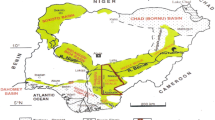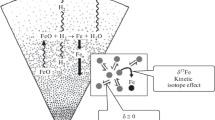Abstract
Cr, Fe, Rb, Ba and U were determined by inductively coupled plasma sector field mass spectrometry (ICP-SFMS) in various sections of the 3,270 m deep ice core recently drilled at Dome C on the high East Antarctic plateau as part of the EPICA program. The sections were dated from 263 kyr bp (depth of 2,368 m) to 672 kyr bp (depth of 3,062 m). When combined with the data previously obtained by Gabrielli and co-workers for the upper 2,193 m of the core, it gives a detailed record for these elements during a 672-kyr period from the Holocene back to Marine Isotopic Stage (MIS) 16.2. Concentrations and fallout fluxes of all elements are found to be highly variable with low values during the successive interglacial periods and much higher values during the coldest periods of the last eight climatic cycles. Crustal enrichment factors indicates that rock and soil dust is the dominant source for Fe, Rb, Ba and U whatever the period and for Cr during the glacial maxima. The relationship between Cr, Fe, Rb, Ba and U concentrations and the deuterium content of the ice appears to be similar before and after the Mid-Brunhes Event (MBE, around 430 kyr bp). Mean concentration values observed during the successive interglacials from the Holocene to MIS 15.5 appear to vary from one interglacial to another at least for part of the elements. Concentrations observed during the successive glacial maxima suggest a decreasing trend from the most recent glacial maxima (MIS 2.2 and 4.2) to the oldest glacial maxima such as MIS 14.2, 14.4 and 16.2, which could be linked with changes in the size distribution of dust particles transported from mid-latitude areas to the East Antarctic ice cap.
Similar content being viewed by others
References
Bassinot FC, Labeyrie LD, Vincent E et al (1994) The astronomical theory of climate and the age of Brunhes-Matuyama magnetic reversal. Earth Planet Sci Lett 126:91–108
Berger A, Loutre MF (2003) Climate 400,000 years ago, a key to the future? In: Droxler AW, Poore RZ, Burckle LH (eds) Earth’s climate and orbital eccentricity: the marine isotopic stage 11 question. American Geophysical Union, Washington, DC, pp 7–26
Berger WH, Wefer G (2003) On the dynamics of the ice ages: stage-11 paradox, mid-Brunhes climate shift, and 100-kyr cycle. In: Droxler AW, Poore RZ, Burckle LH (eds) Earth’s climate and orbital eccentricity: the marine isotopic stage 11 question. American Geophysical Union, Washington, DC, pp 41–59
Boutron CF (1990) A clean laboratory for ultralow concentration heavy metals analysis. Fresenius J Anal Chem 337:482–491
Boutron CF, Patterson CC (1986) Lead concentration changes in Antarctic ice during the Wisconsin/Holocene transition. Nature 323:222–225
Candelone JP, Hong S, Boutron CF (1994) An improved method for decontaminating polar snow and ice cores for heavy metals analysis. Anal Chim Acta 299:9–16
Delmonte B, Petit JR, Maggi V (2002) Glacial to Holocene implications of the new 27,000-year dust record from the EPICA Dome C (East Antarctica) ice core. Clim Dyn 18:647–660
Delmonte B, Basile-Doelsch I, Petit JR et al (2004) Comparing the EPICA and Vostok dust records during the last 220,000 years: stratigraphical correlation and provenance in glacial periods. Earth Sci Rev 66:63–87
Droxler AW, Alley RB, Howard WR et al (2003) Unique and exceptionally long interglacial marine isotope stage 11: Window into earth warm future climate. In: Droxler AW, Poore RZ, Burckle LH (eds) Earth’s climate and orbital eccentricity: the marine isotopic stage 11 question. American Geophysical Union, Washington, DC, pp 1–13
EPICA community members (2004) Eight glacial cycles from an Antarctic ice core. Nature 429:623–628
Gabrielli P, Planchon FAM, Hong S et al (2005a) Trace elements in Vostok Antarctic ice during the last four climatic cycles. Earth Planet Sci Lett 234:249–259
Gabrielli P, Barbante C, Boutron C et al (2005b) Variations in atmospheric trace elements in Dome C (East Antarctica) ice over the last two climatic cycles. Atmos Environ 39:6420–6429
Gabrielli P, Barbante C, Turetta C et al (2006) Direct determination of rare Earth elements at the subpicogram per gram level in Antarctic ice by ICP-SFMS using a desolvatation system. Anal Chem 78:1883–1889
Hinkley TK, Matsumoto A (2001) Atmospheric regime of dust and salt through 75,000 years of Taylor Dome ice core: refinement by measurement of major, minor, and trace metals suites. J Geophys Res 106:18, 487–18, 493
Hong S, Kim Y, Boutron CF et al (2003) Climate-related variations in lead concentrations and sources in Vostok Antarctic ice from 65,000 to 240,000 years BP. Geophys Res Lett 30(22):2138–2142
Hong S, Boutron CF, Gabrielli P et al (2004) Past natural changes in Cu, Zn and Cd in Vostok Antarctic ice dated back to the penultimate interglacial period. Geophys Res Lett 31:L20111
Hong S, Boutron CF, Barbante C et al (2005) Glacial-interglacial changes in the occurence of Pb, Cd, Cu and Zn in Vostok Antarctic ice from 240,000 to 410,000 years BP. J Environ Monit 7:1326–1331
Jansen JHF, Kuijpers A, Troelstra SR (1986) A mid-Brunhes climatic event: long term changes in global atmospheric and ocean circulation. Science 232:619–622
Krinner G, Genthon C (2003) Tropospheric transport of continental tracers towards Antarctica under varying climatic conditions. Tellus 55(B):54–70
Lambert F, Delmonte B, Petit JR et al (2008) Dust–climate couplings over the past 800,000 years from the EPICA Dome C ice core. Nature 462:616–619
McManus JF (2004) A great grand-daddy of ice cores. Nature 429:611–612
Ng A, Patterson CC (1981) Natural concentrations of lead in ancient Arctic and Antarctic ice. Geochim Cosmochim Acta 45:2109–2121
Parrenin F, Barnola JM, Beer J et al (2007) The EDC3 chronology for the EPICA Dome C ice core. Clim Past 3:575–606
Petit JR, Jouzel J, Raynaud D et al (1999) Climate and atmospheric history of the past 420,000 years from the Vostok ice core, Antarctica. Nature 399:429–436
Planchon F, Boutron CF, Barbante C et al (2001) Ultrasensitive determination of heavy metals at the sub-picogram per gram level in ultraclean Antarctic snow samples by inductively coupled plasma sector field mass spectrometry. Anal Chim Acta 450:193–205
Raymo ME, Oppo DW, Curry W (1997) The mid-Pleistocene climate transition: a deep-sea carbon isotopic perspective. Paleoceanography 12:546–559
Revel-Rolland M, De Deckker P, Delmonte B et al (2006) Eastern Australia: a possible source of dust in East Antarctica interglacial ice. Earth Planet Sci Lett 249:1–13
Röthlisberger R, Mulvaney R, Wolff E et al (2002) Dust and sea-salt variability in central East Antarctica (Dome C) over the last 45 kyrs and its implications for southern high latitude climate. Geophys Res Lett 29:1963–1966
Rudnick RL, Fountain DM (1995) Nature and composition of continental crust: a lower crustal perspective. Rev Geophys 33:267–309
Vallelonga P, Van de Velde K, Candelone JP et al (2002) Recent advances in measurement of Pb isotopes in polar ice and snow at sub-picogram per gram concentrations using thermal ionisation mass spectrometry. Anal Chim Acta 453:1–12
Vallelonga P, Gabrielli P, Rosman K et al (2005) A 220 kyr record of Pb isotopes at Dome C Antarctica from analyses of the EPICA ice core. Geophys Res Lett 32:L01706
Wedepohl KH (1995) The composition of the continental crust. Geochim et Cosmochim Acta 59:1217–1232
Wolff EW, Fischer H, Fundel F et al (2006) Southern Ocean sea-ice extent, productivity and iron flux over the past eight glacial cycles. Nature 440:491–496
Wolff E, Fischer H, Lüthi D et al (2007) The occurrence and structure of interglacials in the late Quaternary. Presentation at the 32nd General Assembly of the European Geosciences Union, Vienna, Austria, 15–20 April
Author information
Authors and Affiliations
Corresponding author
Rights and permissions
About this article
Cite this article
Marteel, A., Gaspari, V., Boutron, C.F. et al. Climate-related variations in crustal trace elements in Dome C (East Antarctica) ice during the past 672 kyr. Climatic Change 92, 191–211 (2009). https://doi.org/10.1007/s10584-008-9456-3
Received:
Accepted:
Published:
Issue Date:
DOI: https://doi.org/10.1007/s10584-008-9456-3




